The false exerts an immense attraction on beautiful souls.
Infinitely more than the truth.
Although it ends up prevailing, many work hard for the lie, they find in it some Luciferian flashes whose charm they find it impossible to escape.
It has been this way since the beginning of time, since Adam was passed a deceptive apple.
Furthermore, the lie is easier:
the masses can misrepresent a fact in a thousand ways
, but only one path leads to the truth, often lonely and narrow.
These two pieces of news coincided last week: some writings by
Pablo Neruda
went up for auction
, many of them false and others doubtful, and the directors of the Barcelona Football Club denounced what, in their opinion, are more than five thousand false signatures in I don't know what endorsements.
In reality, both events are not at all extraordinary: prisons are full of people who have forged a signature on a bank check, an official document or a private document of sale.
In all those cases it was about cheating someone and making a profit ...
In the field of literature and the university, the trafficking of counterfeits is also very large, although it
is rare to find in prison someone who plagiarizes a novel or a doctoral thesis
.
This would be fine, I understand it, but it has never happened and it is not going to happen, especially now that we have a president and a vice president of the government who will amend the Penal Code for their own account and to get the secessionists out of jail. Catalans, great scammers.
Unlike these, there is a class of counterfeiters who enjoy a murky admiration.
Literature is full of works that gloss over his abilities.
May I now remember
The Con man and His Disguises
, by
Melville
, and
The Fake Purses
, by
André Gide
(the latter with a very convoluted plot, like the sublime scripts of
Dashiell Hammett
, in which you hardly find out anything).
The counterfeiter is often called "the artist."
In the underworld he is greatly admired.
By this they imply that what real artists do is no more worthy than a good imitation of a banknote.
In addition, they see theirs as an abstraction (money is extremely so) that defrauds an also abstract entity (the State) in a bloodless way, since the fake purse sees itself as a mosquito that sucks a micron of the sweet blood of the Treasury.
Of course,
all that popular indulgence disappears when the counterfeit bill touches you
and they put you in the humiliating position of looking for a wretch like you to put it on.
The case of forgeries of works of art, poetic manuscripts and other matters related to the spirit (after all the coin is a replica of gold, "the vile metal") is more interesting, it has at least one sophisticated point.
The story of
Mark Hofmann
(
Simon Worrall's
The Poet and the Killer
), one of America's great forgers,
was published years ago
.
If he has not been taken by the virus, he is serving a life sentence for forgery and murder: in his case one thing led to another.
From his hands came forgeries of
Lincoln
and
Washington
, including a poem by
Emily Dickinson
, millions of dollars he obtained from individuals and antique dealers.
Many of these papers managed to fool the federal authorities and the leading experts at such prestigious auction houses as Sotheby's and Christie's.
The question psychologists ask themselves is always the same: why are people fooled, even when the fakes are crude and sloppy?
TS Eliot spoke of "the voluntary suspension of the will."
And that's what happens.
Nobody wants to be lied to, but we are willing to be fooled if someone does it with enough "art".
We want the false to be true, and for this we anesthetize our capacity for understanding and criticism, if necessary.
And because?
Because we need to believe.
Today the true counterfeit purses do not stamp or mint money.
They are not part of organized crime.
They are fake white glove purses.
They are in the governments of half the world cranking the false news, the fraud of law and the false data.
And people, who do not even know how to distinguish them from the real ones, help them to circulate them.
They are worth to him as they come, they cannot escape their charm.
Until reality, the only unappealable authority, one day interrupts that wheel and says: "With this filfa you can't buy anything."
Of course, it can happen like in
The Man Who Was Thursday
, you know, the one who discovered that the dangerous anarchist lodge he entered was made up only of infiltrated policemen who were persecuting themselves.
I mean that reality, all of it, may end up being the masterpiece of fake purses.
It happened in the Third Reich and in the USSR.
If this happens again, we are lost.
According to the criteria of The Trust Project
Know more
United States
literature
Opinion
Columnists
culture
Global Patio Identity
FiguracionesSpain in black and white
That's me in the cornerGregorio Morán y la censura
See links of interest
News
TV programming
Translator
Calendar
Films
Topics
Movistar Students - Herbalife Gran Canaria
Barça - Panathinaikos
13th stage of the Giro d'Italia, live: Cervia - Monselice

